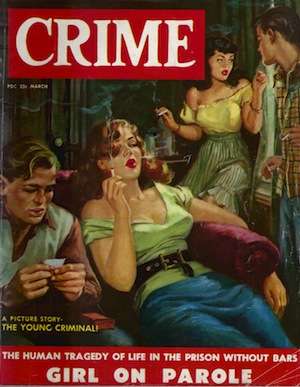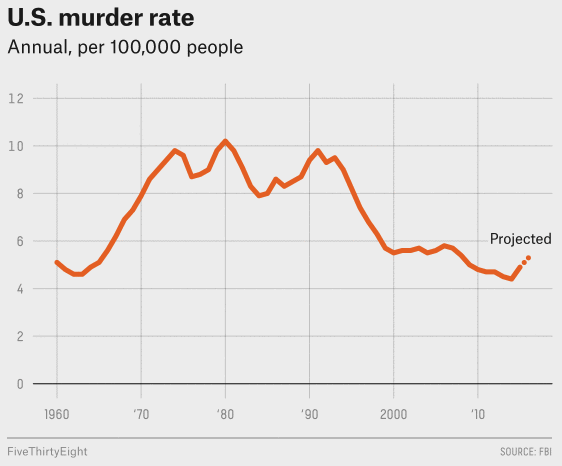FBI: Violent Crime Up, Property Crime Down
The bureau releases preliminary crime numbers for the first half of 2016.


The FBI has just put out its preliminary report on crime in the first half of 2016. The news is mostly bad, with violent crime increasing 5.3 percent since the previous year. Since the FBI's stats also showed violent crime going up in 2015, there's a good chance we're on track for two consecutive years of rises. (The full report on 2016's crime rates won't come out until the fall.)
Specifically, the report shows murders up 5.2 percent, aggravated assaults up 6.5 percent, violent robberies up 3.2 percent, and rape rising either 3.2 or 3.5 percent, depending on how you define the crime. (The FBI revised its definition of rape in 2013, but it continues to offer statistics for both the old definition and the new one.) Property crime, on the other hand, showed a very slight decline, though one particular property offense—auto thefts—became more common. All this is roughly similar to the trendlines from 2015, which also saw an overall increase in violent crime, an overall decrease in property crime, and an auto-theft exception to the property-crime decline.
Since this year and a half of increases follows a two-decade drop in crime rates, these levels remain low by historical standards. (That's not true of some specific places, such as Chicago and Baltimore, that are undergoing undeniable crime crises. But these numbers offer a nationwide perspective.) The unanswered question is what these rises represent. Is this a new trend that threatens to undo the gains of the '90s and '00s? Is it a temporary shift, comparable to the brief hike we saw in the mid-'00s before the rates resumed their fall? Or is it something else?
John Pfaff, a Fordham law professor and the author of the forthcoming Locked In: The True Causes of Mass Incarceration and How to Achieve Real Reform, offers a third hypothesis. "Sometimes a rise in crime is causal—the rise in murders that started in 1985 was due to crack-market related violence," he says. "But any rise (or fall) in crime is also partly just noise. So it's perfectly plausible to look at, say, murder rates and say that the mean was about 9 per 100,000 during the high-crime era, with a lot of 'noisiness' around that. The same story may be true now: Perhaps with hindsight we'll realize that the mean murder rate is now going to be around 6, with some good or bad years on either side of that. What some are viewing as a 'rise in crime' could instead just be more a regression to the mean, and to a mean that is still much lower than it was 20 years ago."
Just to muddy matters more, the other major measurement of crime in America—the National Crime Victimization Survey—actually showed nonfatal violent crime going down in 2015. (We do not yet have their 2016 results.) The FBI's count and the NCVS count each have their strengths and weaknesses, so that isn't a rival narrative so much as it's a sign that there are limits on our ability to perceive the "real" crime rate. There are two major measurements of crime in America, and at the moment they diverge. (For more on the differences between the NCVS numbers and the FBI's numbers, go here.)
Murder, in any event, does seem to be on track to go up for two years running. The NCVS doesn't cover homicides (by definition, murder victims can't be surveyed), and the FBI numbers probably aren't far off (as the saying goes, bodies are hard to hide). While we don't have the FBI's numbers for the second half of 2016 yet, many jurisdictions do have preliminary counts for the full year. Over at FiveThirtyEight, Jeff Asher has gathered data from most of the country's big cities, and he's projecting that we'll ultimately see a national rate of about 5.3 murders for every 100,000 people in 2016—slightly less than in 2008:

So the numbers are still far lower than in most of the last half-century, but that line isn't pointing in the direction we want. Pfaff, who worries about the costs of overreacting to crime as well as the costs of crime itself, offers this takeaway: "Don't be complacent, but don't panic."
Show Comments (30)